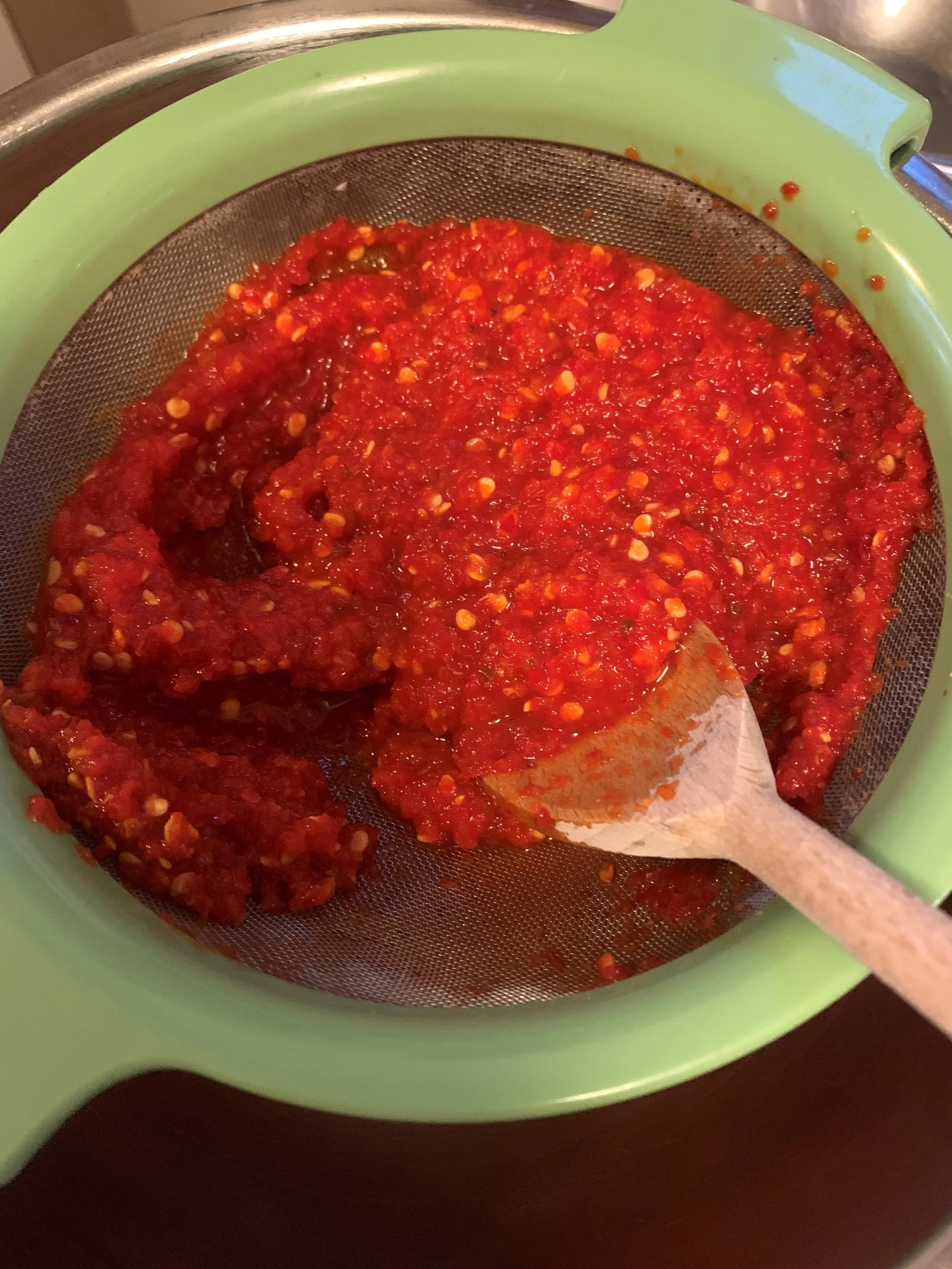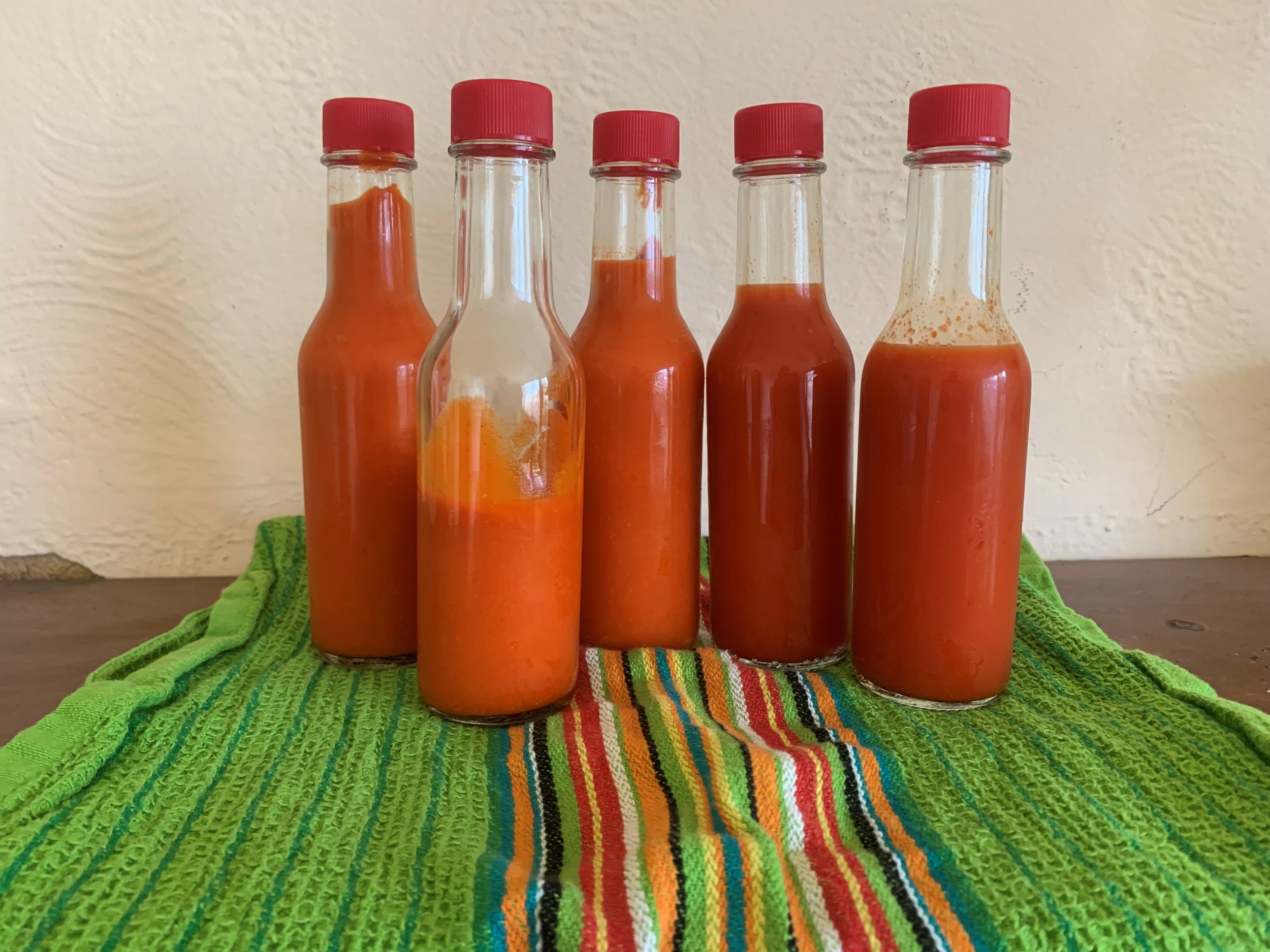Make Your Own Sriracha!
by Vicki Medland
Sriracha (say it See-racha) is the favorite hot sauce in the US, at least according to a recent survey by Instacart.com. And for most of us the only bottle we grab is the one with the bright green cap and the rooster on the front made by Huy Fong Foods. Sriracha hails from Thailand, but Rooster brand is a US original, created in the 1970s by David Tram in California using jalapeños instead of the traditional Thai peppers.
Traditional Thai Sriracha isn’t much older. It was invented by Thanom Chakkapak in 1949 who named it after her home town of Sri Racha, Thailand. She mixed together a paste of fermented pepper and garlic with sugar, salt and vinegar and sold it to local restaurants. Her Siraja panich became popular with locals and tourists alike, inspiring several makers in Thailand, Vietnam, and the US to introduce their own versions.
All srirachas share the same base ingredients, but each has its own flavor profile depending on what peppers they use and by varying proportions or adding additional ingredients. Most Thai and Vietnamese versions are thinner, fruiter, medium hot (averaging 2500-5000 Scoville heat units), and sweeter because they use prik chi faa (spur) peppers. Rooster brand is hotter (5000-10,000 scoville heat units), less sweet, and a touch bitter from the red jalapeños. Some of the US craft Sriracha bottlers are now using Fresno chile peppers, which are fruiter, smokier, and usually less hot than jalapeños. Three Mountains brand is even making a citrusy hot yellow version using Thai burapa peppers (75,000-100,000 Scoville units) .
I first became interested in making my own sriracha last February when I could no longer find Rooster sauce and the other brands doubled in price. In the United States, the sauce is made with peppers that all ripen at the same time, tying production directly to the growing season. All the sauce is made within a few weeks of harvest and then bottled and sold throughout the year. Huy Fong Foods Rooster Sauce dominates US production and controls 10% of the global hot sauce market. However, they depend on just a few growers in northern Mexico for their jalapenos. After a two-year drought decimated the spring crop, Huy Fong had to wait for the summer crop to mature in July before more sauce could be processed.
But there is no need to fear another sriracha crisis. Make your own! It’s very easy to make as long as a source of ripe peppers can be found. Peppers mature from green to another color (usually red) as they ripen.
Ripe peppers are harder to find than the immature green for several reasons. Plants must be cared for longer in the field to allow the fruit to ripen completely and ripe fruit are more fragile and have a shorter storage time. Orange or yellow peppers will work just as well as red, just be sure they are a thick-walled variety, otherwise there will not be enough pulp for the sauce. Check at your farmers market for peppers. Even if they are only selling green peppers, they may reserve some to ripen if you order ahead of time. I ordered mine from local urban farmers, Valentine Gardens. Mexican and Asian grocers may carry ripe peppers. Or, grow your own. Just do not use green peppers. The sauce will have a grassy flavor with little sweetness and will oxidize to an olive brown color over time.
Grow your Own Sriracha Peppers
Jalapeños and prik chi faa peppers are good choices for northern gardens. They both ripen in 90 days or less and thrive in our climate. A quart of sriracha sauce requires about 2 lbs of peppers. Production varies of course, but well-tended plants that have full sun and lots of space will produce 20-30 fruits so 3 plants should provide more than you need for one recipe.
Thai varieties can be harder to find, but a good choice is the Prik chi faa offered by Adaptiveseeds.com that was developed for northern climates. Jalapeño seeds are easy to find, but varieties vary considerably in heat and time to maturity. Johnnyseeds.com has an early variety that is ripe in just 80 days. Many suppliers carry TAM jalapenos, an early variety developed at Texas A & M that is has much less heat than other jalapenos. Several peppers have Fresno in the name. Make sure to choose a variety with wide shoulders and tapered tips that grow tips-up.
Sriracha can be made by fermenting or cooking. The traditional method requires a short fermentation of three days to two weeks. Fermentation will produce a brighter, more complex and authentic sriracha flavor. It will be less hot than the cooked version because fermentation breaks down on some the capsaicin heat molecules in hot peppers. It will also be chock-full of healthy probiotics. The cooked version will taste flatter and require the addition of more vinegar to get the right tanginess.
Sriracha Hot Sauce Recipe (adapted from Joshua Bousel on Serious Eats)
Equipment needed: food processor, one or two quart jars with lids, strainer and bowl, spatula, chefs knife, blender
1 1/2 pounds ripe peppers
6 cloves garlic, peeled
4 tablespoons brown sugar
1 tablespoon kosher salt
1/2 cup distilled white vinegar
Fermented Version
Cut the woody stems off the peppers. It’s fine to leave the green caps on because everything gets ground up and the less you have to handle the raw peppers the better.
Add the peppers, garlic, sugar, and salt to a food processor or blender and grind into a paste.
Put the mix into one or two clean quart jars and cover loosely. Do not overfill the jars, the paste will expand with gas bubbles as it ferments.
Allow to ferment in a cool dark place for two to five days, mixing daily with a non-reactive spoon.
5 day jar- Finished: once the paste becomes more liquid and stops producing bubbles, the ferment is finished. Longer fermentation will result in a less sweet sauce as the probiotic bacteria consume more sugars.
Add the rest of the ingredients and mix well. Process or blend the mixture and press through a sieve. Taste and add a bit more sugar, salt or vinegar if desired. Add a little water if the sauce is too thick to pour.
Heat on medium, stirring until it thickens if needed, but you may lose some of the healthy probiotic bacteria. Pour into bottles or jars and refrigerate. The sauce will keep for several months if it lasts that long.
Cooked Version
Fermenting the peppers will give you the most authentic flavor, and infuse the sauce with probiotics, but if that is not your thing, the sauce can be cooked. In fact, frozen peppers will work just fine in a cooked sauce. Consider chopping and freezing peppers at the end of the season and you can mix up this sauce anytime.
Slice the peppers and garlic and simmer in enough water to cover until softened. Most of the seeds will fall out and collect at the bottom.
Strain out the peppers and garlic and discard the water and seeds. Add the rest of the ingredients and process or blend until smooth. This will make a milder sauce, but the flavor will be less bright than the fermented version.
Taste and add a bit more sugar, salt or vinegar if desired. Pour into bottles or jars and refrigerate. The sauce will keep for several months.



